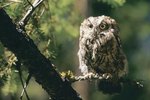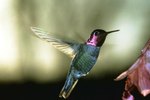
The Mojave Desert is situated in the southwestern portion of the United States, where it's made up of parts of California, Utah, Nevada and Arizona. The desert is a hub for wildlife, including birds. Many diverse varieties of birds spend time in the Mojave Desert -- some simply passing through during migration and others that are full-time inhabitants.
Le Conte's Thrashers
Le Conte's thrashers (Toxostoma lecontei) live full-time in the Mojave Desert. The meek birds are kin to mockingbirds and have pale yellowish-brown feathers that blend in seamlessly with their environments. They generally grow to lengths of around 10 inches. Le Conte's thrashers have clandestine natures and, as a result are usually hard to track down. They gravitate to the Mojave Desert's often open and airy settings.
Bendire's Thrashers
Bendire's thrashers (Toxostoma bendirei) live not only in the United States' southwestern region, but also in the northwestern region of Mexico. The California population of Bendire's thrashers tends to stay in the Mojave Desert, in scrubby habitats with lots of tall plants. These unassuming brownish-gray songbirds are notable for their smooth trills. They typically reach mature lengths of between 9 and 11 inches.
Scott's Orioles
Scott's orioles (Icterus parisorum) are visually striking songbirds that are usually found in close proximity to Joshua trees in the Mojave Desert. Adult Scott's orioles usually grow to anywhere between 7.5 and 8.25 inches long. The male plumage is a striking combination of jet black and vivid yellow. The females' feathers are a combination of pale greenish-yellow and blackish-brown. The birds' reproduction occurs in the United States, and they tend to move south for the coldest months of the year.
Burrowing Owls
Burrowing owls (Athene cunicularia) are notable for their smallish size -- with their typical adult lengths of anywhere from 7.5 to almost 10 inches. As their names indicate, they indeed spend a lot of time in underground retreats. Burrowing owls' feathers are a blend of white and brown elements. They're highly attracted to arid settings that are free of trees. They can adjust easily to many different kinds of habitats, and as a result are frequently spotted not far from people in graveyards, in parking lots and on college campuses.
Costa's Hummingbirds
Costa's hummingbirds (Calypte costae) reproduce both in the Mojave and Sonoran deserts. The top plumage of these wee birds is green. The males are memorable due to the luminous purple coloration of their throats and crowns. When the winter rolls around, Costa's hummingbirds tend to head south into northern Mexico.
References
- The Cornell Lab of Ornithology All About Birds: Le Conte's Thrasher
- National Audubon Society Birds: Le Conte's Thrasher
- The Cornell Lab of Ornithology All About Birds: Bendire's Thrasher
- National Audubon Society Birds: Bendire's Thrasher
- San Diego County Plant Atlas: Bendire's Thrasher
- Cornell Lab of Ornithology All About Birds: Scott's Oriole
- National Audubon Society Birds: Scott's Oriole
- Defenders of Wildlife: Burrowing Owl
- Cornell Lab of Ornithology All About Birds: Burrowing Owl
- National Audubon Society Birds: Costa's Hummingbird
Resources
- Cornell Lab of Ornithology All About Birds: Costa's Hummingbird
- Nevada Department of Wildlife: Conservation Practices for Birds in Nevada
- National Wildlife Refuge Association: Southern Nevada - Mojave Desert
- The Nature Conservancy: Visit California's Mojave Desert
- American Bird Conservancy: Sonoran and Mojave Deserts
Photo Credits
-
Jupiterimages/Stockbyte/Getty Images




